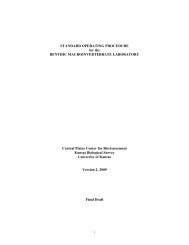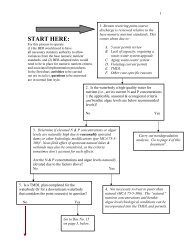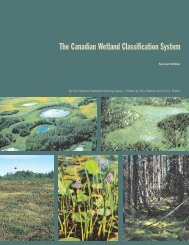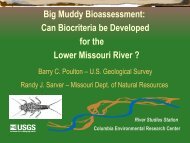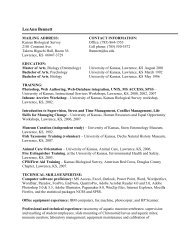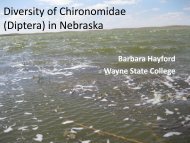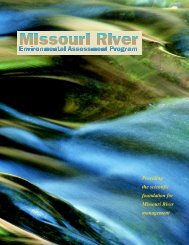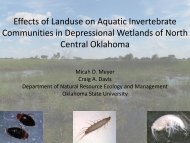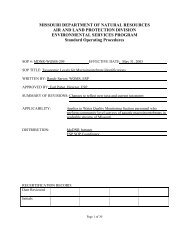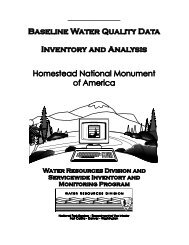Koontz, J., D.G. Huggins, C.C. Freeman, D.S. Baker - Central Plains ...
Koontz, J., D.G. Huggins, C.C. Freeman, D.S. Baker - Central Plains ...
Koontz, J., D.G. Huggins, C.C. Freeman, D.S. Baker - Central Plains ...
You also want an ePaper? Increase the reach of your titles
YUMPU automatically turns print PDFs into web optimized ePapers that Google loves.
ecoregions. Mean pH was also found to be significantly different (p = 0.030) between the CIP<br />
and WCB. Mean pH among the wetland sites in the CIP was approximately 0.5 pH lower than<br />
the Western Corn Belt <strong>Plains</strong> (mean pH = 8.06). Despite these findings, no ecoregional<br />
differences were observed in the Macroinvertebrate MMI and no interactions were observed<br />
when a multiple factor ANOVA was performed between study populations and ecoregion<br />
factors. While no significant ecoregional differences in the MMI scores were found the general<br />
scoring tends for ecoregions indicated that higher scores were associated with WCB, then CIP<br />
and lastly the Interior River Valleys and Hills (Figure 51).<br />
MMI Scores<br />
100<br />
90<br />
80<br />
70<br />
60<br />
50<br />
40<br />
30<br />
20<br />
10<br />
0<br />
Figure 51. Median Box plots of the MMI scores for the entire sample population (n = 53) by<br />
ecoregion: CIP = <strong>Central</strong> Irregular <strong>Plains</strong>, WCB = Western Corn Belt <strong>Plains</strong>, and IRV = Interior<br />
River Valleys and Hills. Box area represents inner quartile range, while “whiskers” represent the<br />
upper and lower observations.<br />
Differences in Wetland Types<br />
CIP WCB<br />
Ecoregion<br />
IRV<br />
Many significant differences were found between the wetland types for many of the FQA<br />
metrics, DA scores, and some water quality parameters. Total organic carbon concentrations<br />
(TOC), log Secchi depths (m), and log total nitrogen concentrations (TN) also showed similar<br />
significant separations between wetland types. ANOVA and Kruskal-Wallace non-parametric<br />
tests identified significant differences between palustrine and lacustrine sites in many of the FQA<br />
metrics and depth, though riverine wetlands seemed to separate with indicators of degradation,<br />
such as increased percent adventives species, lower native richness, and overall FQI scores.<br />
Between class and type differences were observed, but not all were statistically significant<br />
(Figure 52a and b). Examination of water quality, FQA, and Macroinvertebrate MMI variables<br />
and their values suggest that the MIX most closely related to UB and these sites probably should<br />
be re-classed as UB sites. FQI means and mean native plant richness differences were not<br />
71 of 84



